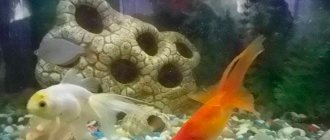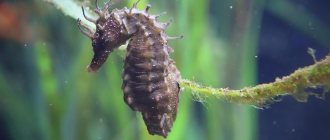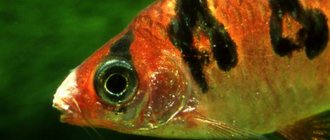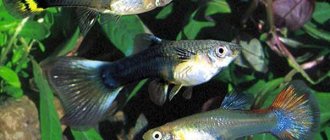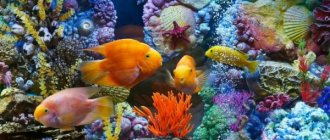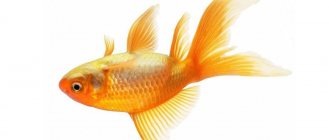Sometimes guppy lovers notice that their fish's behavior has changed and they constantly swim on the surface. What to do in this case, and what could this be connected with?
Before you take any action, you need to know that guppies are fish that live in the upper layers of water, so if they sometimes hover near the surface, then there is nothing wrong with such actions. But you should pay attention if the guppies are constantly near the surface. There may be several reasons: lack of oxygen, poor water quality and various fish diseases.
Why do fish start to die?
Newbie mistakes lead to the death of fish. The most common ones are listed below.
Water pollution
Guppies die from contamination in the aquarium, which causes disease, poisoning and lack of oxygen. The liquid must be free of impurities and dechlorinated.
Nitrogen poisoning
When poisoned by nitrogen compounds, the fish's eyes bulge and it shows signs of oxygen starvation. Increase aeration and replace up to 40% of the liquid. Find out how much the concentration of nitrogen compounds in the water is and neutralize the excess using conditioners.
Water temperature
If guppies are kept at inappropriate temperatures (22-28 degrees), they are susceptible to disease. A sudden change in temperature leads to temperature shock and death.
Incorrect launch of fish
Neglecting quarantine when introducing a new fish can lead to the fish dying one by one. The new fish should be observed in a separate container for at least 3-4 weeks, and only if there are no diseases can it be placed in a common aquarium. It is also necessary to gradually adapt newly acquired fish to the conditions of a particular aquarium. Do not release the fish from the bag into the aquarium immediately; add new water little by little every 15–20 minutes.
Fish diseases
Diseases are a common cause of death. Observe the behavior and appearance of the fish, do not delay treatment if you suspect a disease.
Water quality
The quality of the water environment is declining due to:
- Irregular or incomplete aquarium maintenance. Proper care involves siphoning the soil, replacing 25% of the total volume of liquid with clean liquid, and washing the decorations and filter components.
- Overfeeding Excess feed falls to the bottom, polluting the water. Feed your pets small portions and fast them once a week.
- Overpopulation. In a densely populated aquarium, the liquid becomes contaminated faster.
- Lack of equipment. The liquid needs constant filtration and aeration. An aquarium without equipment requires frequent water changes.
Guppy swims belly up
There are many reasons why a fish can swim belly up, here are some of them:
- Viral or bacterial infections;
- Infestation with parasites;
- Cancer or fungal diseases;
- General weakness;
- Starvation;
- Fin or swim bladder disease;
- Increased gas formation in the gastrointestinal tract.
But the main reason should be considered inflammation of the bladder - this is a contagious disease that is caused by infection. The disease was first identified in the 50s. Infection occurs due to poor quality food and improper aquarium conditions.
Forms of the disease:
- Acute – occurs in severe form, lasts 6-7 days. The guppy stops eating, falls over on its side or upside down, and begins to float belly up. The internal organs begin to become inflamed, and curvature of the spine occurs. The bladder becomes covered with purulent ulcers, which gradually penetrate inside. The fish lose a lot of weight and die.
- Chronic – is not so acute, lasting about a month. Guppy eats, but very little. Inflammation of the organs and bladder becomes purulent. The bubble gradually changes its shape and due to lack of oxygen, the fish swims close to the surface with its belly up.
If you start treating your fish as soon as the first symptoms appear, the prognosis may be favorable. During the treatment period, guppies must be left without food, this will help stop the inflammation process.
Diseases
The list of diseases of aquarium fish is huge; experienced aquarists and people with special education understand them. If you lack experience, it is better to consult a doctor.
Fin rot
The disease appears in dirty water when the fins are injured. If you ignore the disease, after the destruction of the fins, damage to the body will begin and the fish will die. Fin rot is treated:
- Salt baths. Immerse the sick individual in a solution of table salt (3 tablespoons per 5 liters of water) for 10–15 minutes. Treat the decorations and soil.
- Levomycetin. Dissolve 1 tablet for every 20 liters of water. Once every three days, add a solution in an amount of up to 30% of the aquarium volume. Carry out treatment until complete recovery.
There are many methods for treating fin rot. The treatment is discussed in detail in a separate article.
Plistophorosis
The disease is also called “neon disease” and pleistophorosis. The fish's muscles are affected and ulcers appear on the body. Plistophorosis cannot be treated; the diseased individual must be destroyed. Boil the soil and decor, rinse the aquarium.
Red scab
The disease most often affects males. Remove the parasite-affected areas of the fins with a blade. Place the guppies in salted water (1 g salt per 1 liter). Treat in combination with levomycin (1 tablet per 30 l) or furazolidone (0.5 tablets per 10 l). The course of treatment is 5 days. Remedies for ichthyophthyriosis also help. The tail grows back after some time.
Scoliosis
If the spine is curved, and no other symptoms of disease are observed, then the curvature may be congenital. Individuals with scoliosis can lead normal lives, but they are smaller and weaker than healthy guppies. Scoliosis that appears in an adult fish can be corrected by reducing portions during feeding and introducing variety into the diet. During pregnancy, the female monitors the aeration in the aquarium and does not allow inbreeding.
Tetrachymenosis
The ciliates Tetrahymena infect the gills and fins. Place the sick fish in salted water (1 g of salt per 1 liter) with increased aeration. Add a solution of biseptol (1 tablet per 50 liters of water) or furazolidone (0.5 tablets per 10 liters) into the water. Prevent healthy fish by mixing a small amount of furazolidone with food.
Tuberculosis or mycobacteriosis
In addition to weight loss and curvature of the spine, there is a fading of color. Treatment is possible in the early stages; a number of aquarists consider the disease incurable. Place the fish and add kanamycin (30–50 mg per liter) to the water daily for 10–14 days with daily water changes. You can soak the food in a solution of kanamycin (0.5 g of the drug per 100 ml of water). Another method: adding isoniazid (1 tablet per 60 l) for 3 days. Then a break is taken for 2 days. The course is repeated 2-3 times. After transplanting the sick fish, disinfect the aquarium, wash the decorations and boil the soil.
Lack of oxygen in the water and too much feeding
If the guppies die one after another, you should make sure there is enough oxygen in the water. A compressor must be running in the aquarium. As the water temperature rises, the amount of oxygen decreases. This situation can occur at night when the compressor is turned off. Plants also do not produce oxygen in the dark, so it is better to keep the compressor running around the clock.
Pets can also die due to too frequent and abundant feeding. This is especially true among beginner aquarists who have not understood the nuances.
Guppies should not be overfed; the food that remains begins to decompose, releasing toxic substances.
Because of the waste, the water becomes cloudy, the biobalance is disrupted, and the fish die. If you notice that the liquid has begun to lose transparency, clean the bottom of the aquarium and the filter.
Adviсe
- Before you buy new fish, find out what species they are, their environment, and whether they are compatible with guppies.
- A spare aquarium is required for quarantine of new fish, treatment and spawning.
- If you notice something strange in the behavior and appearance of fish in a pet store, refuse to purchase.
- If it is necessary to improve the conditions of water inhabitants, do it gradually. Any sudden changes in the aquatic environment are a source of stress for pets.
- Fish are more comfortable in a rectangular tank rather than a round one.
Advice and treatment methods vary greatly from one source to another. Sometimes sellers in pet stores give harmful recommendations. Consult with experienced aquarists and veterinarians and check the information carefully.
Previous
Diseases10 types of algae and how to combat them in the aquarium
Next
DiseasesHow to get rid of black beard in an aquarium?
About symptoms
If you are concerned about the question of why guppies swim on the surface of the aquarium, first of all, observe exactly how this happens. If the fish occasionally rise to the surface and stay there, but they have a good appetite and playful behavior, then this should not bother you. Guppies live in the middle layers of water, sometimes a little higher, sometimes a little lower, and these are variations of the norm! But be careful, because the following behaviors indicate that the guppies need your help:
- The fish greedily swallows air from the surface;
- The pet has a disturbed appetite;
- Guppy swims vertically;
- The color has faded;
- Gupeshki do not sink lower, spending all their time near the surface;
Sex differences
Guppies exhibit pronounced sexual dimorphism. It is very, very easy to distinguish a female from a male. Males are smaller, slimmer, they have a large caudal fin, and the anal fin has turned into a gonopodium (roughly speaking, this is a tube with the help of which male viviparous fish fertilize the female).
Females are larger, have a large and noticeable belly and are usually quite pale in color.
Even juveniles can be distinguished quite early; as a rule, those of the fry that first began to color will be males.
Creation of necessary conditions of detention
Guppies are considered unpretentious fish, but juveniles require special care. In order for the fry to develop quickly, grow healthy and active, all conditions must be created for them:
- The size of the aquarium for guppy fry should correspond to the number of individuals. The more newborns, the more capacious the vessel. It is preferable for the fish to be kept in a fish tank attached to a common tank.
- Lighting in the first 3-5 days should be around the clock. Then you can gradually reduce the duration of daylight to 16 hours a day.
- The optimal water temperature for fry is +28ºC. During the cold season, a water heater may be required.
- Clean, oxygenated water is an indispensable condition for the health and growth of fish. To maintain the aquatic environment in the aquarium, install the necessary equipment: a filter, an aerator, and also regularly clean the bottom. The filter should be covered with fabric to prevent the fry from being drawn inside.
Proper organization of care for guppy fry involves a diet. If you feed babies whatever you have to and do not observe the frequency of food distribution, they may die.
Habitat in nature
The guppy (Poecilia reticulata) is one of the most widely distributed tropical fish in the world and one of the most popular freshwater aquarium fish species. It is a member of the family Poeciliidae and, like almost all members of the family, is viviparous.
Guppies are native to Antigua and Barbuda, Barbados, Brazil, Guyana, Jamaica, Netherlands Antilles, Trinidad and Tobago, US Virgin Islands and Venezuela. They are very adaptable and thrive in many different environmental conditions.
As a rule, they live in clean, running water, but also like brackish coastal waters, but not salty sea waters.
They feed on worms, larvae, bloodworms and various small insects.
They have been introduced to many countries on every continent except Antarctica. Sometimes this happened by accident, but most often as a means of mosquito control. Guppies were supposed to eat mosquito larvae and help slow the spread of malaria, but in many cases these guppies have had a negative impact on local fish populations.
Research shows that guppies have colonized almost all freshwater bodies of water available to them in their natural ranges, especially in rivers located near the coastal margins of mainland South America. Although guppies are not usually found there, they also tolerate brackish water and have colonized some brackish habitats. They tend to be more numerous in small streams and pools than in large, deep or fast-flowing rivers.
Their name comes from Robert John Lechmere Guppy, who found them in Trinidad back in 1866 and brought them to the British Museum. Since then, the fish has undergone several name changes, including Lebistes reticulatus and is now known as Poecilia reticulata.
There are almost 300 varieties of guppies. They come in a wide variety of colors, sizes, and tail shapes. Males in nature are much brighter than females, but still their coloring is far from the aquarium breeding forms.
She must protect them from predators, since the fish is small and defenseless.
Two or three generations of guppies born in the same year are found in the wild. The fry are well developed and capable of independent existence without further parental care at the time of their birth. Females first produce offspring at 10-20 weeks of age and continue to reproduce until 20-34 months. The reproductive cycle is related to age. Older females produce offspring that are smaller in size and have longer intervals between births.
Males mature in 7 weeks or less. Male and female guppies from regions with high predation rates mature faster and begin reproducing earlier than males from regions with low predation rates. Females from regions with high levels of predation reproduce more frequently and produce more offspring per litter, and are more fertile than females with low levels of predation.
In addition to aging, food availability and density also play a role in regulating guppy populations. Guppies reduce their fertility in response to food scarcity. When there is plenty of food, they increase the size of the brood.
The overall lifespan of guppies in the wild varies greatly, but is usually around 2 years.
Description
As we already mentioned, guppies come in different colors and sizes, with different tail shapes. In the wild, females are usually gray, while males have colorful stripes, spots or splashes in a wide range of colors. There are many species of aquarium guppies due to the efforts of breeders to create new species with brighter colors and more patterns on their bodies and tails.
These fish are sexually dimorphic, meaning you can tell males from females just by looking at them. While females naturally have a gray body color, males have splashes, spots or stripes that can be any of a wide variety of colors.
As for appearance, it is almost impossible to describe. Guppies cross so often and so much that even dozens of selective forms can be counted, and even more common ones. Males and females of many species are typically larger in body size and much more ornate than their wild-type predecessors.
These fish come in almost every color imaginable, usually a paler color on the upper half of the body, and the back half usually a brighter color.
Some types can also have a metallic sheen. They have iridophores, which are cells that have no color and reflect light which creates a metallic effect.
A small fish, and males are smaller than females, and usually reach a length of about 5 cm. Males are usually 1.5-3.5 cm long, and females are 3-6 cm.
A guppy lives for 2-3 years, as its small size and warm water speed up metabolism and shorten its lifespan.
